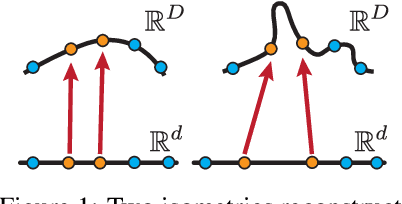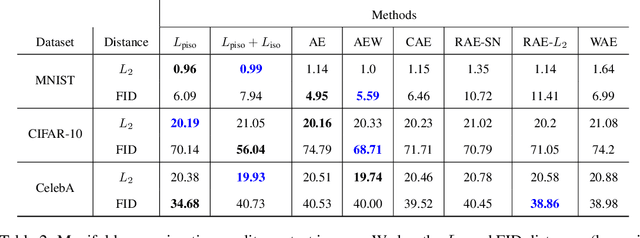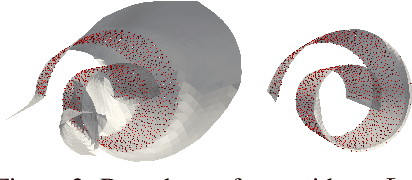Isometric Autoencoders
Paper and Code
Jun 16, 2020



High dimensional data is often assumed to be concentrated near a low-dimensional manifold. Autoencoders (AE) is a popular technique to learn representations of such data by pushing it through a neural network with a low dimension bottleneck while minimizing a reconstruction error. Using high capacity AE often leads to a large collection of minimizers, many of which represent a low dimensional manifold that fits the data well but generalizes poorly. Two sources of bad generalization are: extrinsic, where the learned manifold possesses extraneous parts that are far from the data; and intrinsic, where the encoder and decoder introduce arbitrary distortion in the low dimensional parameterization. An approach taken to alleviate these issues is to add a regularizer that favors a particular solution; common regularizers promote sparsity, small derivatives, or robustness to noise. In this paper, we advocate an isometry (ie, distance preserving) regularizer. Specifically, our regularizer encourages: (i) the decoder to be an isometry; and (ii) the encoder to be a pseudo-isometry, where pseudo-isometry is an extension of an isometry with an orthogonal projection operator. In a nutshell, (i) preserves all geometric properties of the data such as volume, length, angle, and probability density. It fixes the intrinsic degree of freedom since any two isometric decoders to the same manifold will differ by a rigid motion. (ii) Addresses the extrinsic degree of freedom by minimizing derivatives in orthogonal directions to the manifold and hence disfavoring complicated manifold solutions. Experimenting with the isometry regularizer on dimensionality reduction tasks produces useful low-dimensional data representations, while incorporating it in AE models leads to an improved generalization.
 Add to Chrome
Add to Chrome Add to Firefox
Add to Firefox Add to Edge
Add to Edge